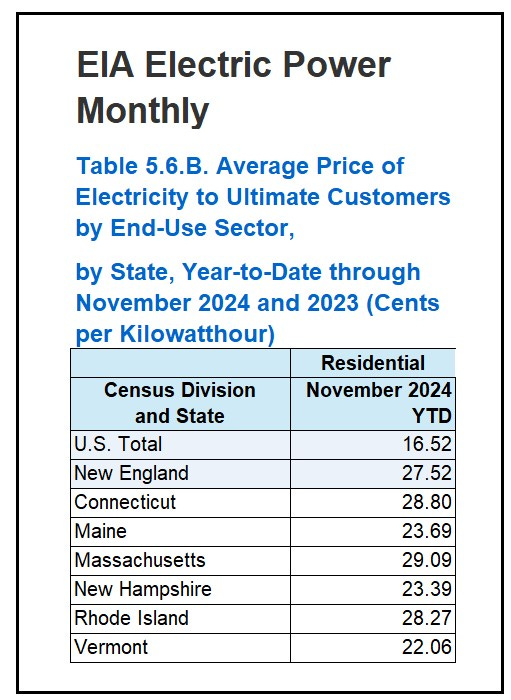New England ISO is facing a worsening energy crisis, with high electricity prices due to unreliable supply. Despite relying on natural gas for over half of its electricity generation, the region’s leaders refuse to allow new pipelines, forcing reliance on expensive imported liquefied natural gas (LNG). This winter’s price spikes once again exposed the consequences of these policies, yet state officials continue to blame utilities rather than address the real issues.
Pipeline Constraints and High Energy Costs
New England’s governors have resisted new natural gas pipelines despite the region’s heavy dependence on gas, which accounted for 51% of electricity generation in 2024. Without adequate pipeline capacity, gas must be imported as LNG—an expensive and inefficient solution further burdened by the Jones Act, which prevents domestic LNG shipments by U.S. vessels. As a result, New England must source LNG from foreign suppliers like Canada and Trinidad and Tobago, increasing costs dramatically.
President Trump recently announced plans to revive the Constitution Pipeline, which would bring natural gas from Pennsylvania’s Marcellus Shale to New York. While New York is not in the New England ISO, its position between New England and major gas fields means this pipeline could significantly improve regional supply. However, New York’s own restrictive energy policies, including bans on new gas infrastructure and a permitting process that effectively blocks pipeline expansions, continue to hinder regional supply.
For comparison, my electric bill in Oklahoma averages 12 cents per kWh, while Massachusetts ratepayers face nearly 30 cents per kWh—and that’s before winter price surges.
Winter Price Spikes: A Predictable Crisis
During the recent cold snap, electricity prices soared due to gas shortages. On February 18, 2025, natural gas in New England traded at $20.21/MMBtu—over three times the Henry Hub price of $6.40/MMBtu. This drove electricity prices to $150–$230 per MWh, far above the U.S. average.
On that same day:
Natural gas provided 36% of electricity generation.
Nuclear supplied 21% (a stable and affordable source).
Electric Imports from Canada (14%) and New York (8%) filled the gap.
Petroleum (6%) was burned as an emergency measure, a costly and environmentally unfriendly solution.
Wind (5%) and solar (1%) provided minimal support.
This crisis is a recurring issue, not an isolated event. In December 2024, New England experienced similar price spikes, with electricity hitting $162.98/MWh on December 26, while natural gas surged to $18.25/MMBtu. These recurring price shocks are a direct result of supply constraints, not utility greed.
Warnings Ignored: NERC’s Reliability Concerns
The North American Electric Reliability Corporation (NERC), which oversees grid reliability across the U.S., Canada, and Mexico, has repeatedly warned that New England’s natural gas dependency poses severe risks. A recent study highlighted that:
The region’s gas system is fully or near fully utilized during extreme cold.
Any disruption, such as pipeline failures or prolonged cold snaps, could severely threaten reliability.
Jim Robb, NERC’s president, put it bluntly: “This untenable situation cannot be mitigated solely by electric system operators... urgent coordination between gas and electric sectors is needed.”
Yet, these warnings continue to be ignored.
Political Deflection Instead of Solutions
In July 2017, Gordon van Welie, President & CEO, ISO-New England, stated, “The region is challenged with natural gas pipeline constraints that cause reliability concerns and price volatility.” Here we are eight years later, having the same conversation.
Another excellent article from July, 2019 titled “Cuomo’s War on Pipelines Hurts New England” explains “New York Gov. Andrew Cuomo has declared war on natural gas pipelines — and New Englanders are caught in the crossfire…in 2016, the New York Department of Environmental Conservation (NYDEC) blocked an interstate gas pipeline project designed to carry fuel from Pennsylvania to consumers in New York and New England…Cuomo’s pipeline blockade is exacerbating the ongoing natural gas shortage in New England at the very time the region’s dependence on gas is growing.”
As a result of these decisions, energy suppliers have repeatedly called for emergency actions to mitigate the effects of these policies.
In October, 2022, “The CEO of Eversource Energy has asked President Joe Biden to suspend a century-old maritime law and consider other measures to boost energy supplies in New England in the event of a colder-than-normal winter and natural gas shortage.”
Rather than acknowledging policy failures, state leaders deflect blame. For example, Massachusetts Governor Maura Healey, facing backlash over soaring utility bills, recently stated: “The Department of Public Utilities needs to take a look at the rates right now. We need to be doing anything and everything we can do as a state to lower heating bills.”
However, she avoids addressing the core issue: When natural gas costs exceed $20/MMBtu, electricity prices will inevitably surge—especially when 25% of New England’s power comes from imports. No amount of rate reviews will change this fundamental reality.
The Path Forward: Addressing the Real Issues
New England’s energy crisis is not due to greedy utilities—it’s the result of bad policy choices. The region has built a natural gas-dependent grid while simultaneously blocking the infrastructure needed to supply it efficiently. This leaves consumers with high costs and unreliable energy.
To fix this, policymakers must:
Approve new pipeline projects to secure affordable domestic natural gas.
Reevaluate LNG import reliance and advocate for Jones Act reform to allow domestic shipments. New England should be pushing for an exception to the Jones Act while waiting on adequate pipeline solutions.
Prioritize nuclear energy expansion, providing a stable and emission-free alternative or addition to gas.
Listen to NERC’s reliability warnings instead of reacting to every crisis with blame-shifting.
Until New England’s leaders take these steps, ratepayers will continue to suffer from high costs and reliability risks—while policymakers pretend the problem is someone else’s fault. By implementing these policies, New England could enjoy lower electricity rates, improved grid reliability, and reduced reliance on volatile foreign energy sources.







